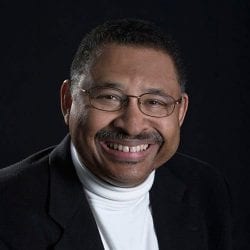Homer A. Neal, a lifelong leader in high-energy physics and higher education, passed away in Ann Arbor, Michigan, on May 23 at the age of 75. He was the Samuel A. Goudsmit Distinguished University Professor of Physics at the University of Michigan, a regent of the Smithsonian Institution, council member of the National Museum of African-American History and Culture, and a director of the Lounsbery Foundation. Neal contributed to a number of significant scientific achievements — including the discovery of the Higgs boson in 2012 — and was a prominent figure in the science policy community, helping shape undergraduate science, technology, engineering and mathematics (STEM) education since the 1980s.
Born in Franklin, Kentucky, Neal took interest in science from a young age, beginning college at the University of Indiana at the age of 15. He earned his B.S. in physics, with honors, there in 1961 and went on to complete his Ph.D. at the University of Michigan in 1966. Neal, beyond his scientific aptitude, had a noted talent for administration — a colleague described him as “a remarkably deft politician”—and he quickly rose through the ranks in academia, taking a position as Dean for Research and Graduate Development at Indiana University in 1976. In 1981, he left Indiana to become Vice President for Academic Affairs and Provost at Stony Brook University. He returned to the University of Michigan in 1987 to chair their physics department, a post which he held until 1993, and remained at Michigan for the rest of his career. He served as the university’s interim president in 1996. Throughout this time, Neal advised many students and faculty, including supervising the thesis of the late Marjorie Corcocan — a long-time particle physicist at Rice University — in 1977 at Indiana.
Neal played a leading role in the D0 experiment, an international collaboration consisting of over a thousand scientists from nearly 100 universities, run out of the Department of Energy’s Fermilab, a large particle accelerators outside Chicago. His research group helped design the detector for the experiment, as well as manage and analyze collision data, which led to the discovery of the top quark — an “elementary” particle that serves as a building block for other matter — in 1995. He was also head of University of Michigan’s ATLAS group from 2000-2015. The group participated in the ATLAS experiment at the European Organization for Nuclear Research (CERN), which houses the world’s largest particle accelerator, the Large Hadron Collider (LHC) in Geneva, Switzerland. The ATLAS experiment was responsible for discovering the Higgs boson in 2012, a feat that earned the Nobel Prize just a year later in 2013, awarded to the two scientists who predicted the particle’s existence.
Neal’s leadership extended far beyond high energy physics. In 1980, he was appointed to the National Science Board (NSB) — an independent advisory body to the National Science Foundation (NSF) — where he served until 1986. Neal chaired the NSB’s first task force on STEM education, in part as a response to the Reagan administration’s efforts to remove education programs from NSF. The study resulted in a widely circulated report, which came to be known as “The Neal Report”; it made policy recommendations to the NSF in light of growing concerns about the health of secondary STEM education in the U.S. The report spurred the creation of the Research Experience for Undergraduates Program (REU) and the Research Experience for Teachers Program (RET), which provide real-world research experiences during the summer. Both programs remain highly active today at universities and laboratories across the country, including an REU program at CERN, piloted by Neal, which is the only formal channel for undergraduates to conduct research at the LHC.
After his tenure at NSB, Neal continued his public service, becoming a prominent “civic scientist” and a visible, influential figure in the broader science policy community. He served as a member of the National Research Council Board on Physics and Astronomy, was a long-time board member of the Ford Motor Company, and served on the American Physical Society (APS) Panel of Public Affairs, becoming its president in 2016. He is a co-author of “Beyond Sputnik: U.S. Science Policy in the 21st Century,” an indispensable resource for students and faculty with an interest in the history, structure, and current challenges of the U.S. science policy system.
Tobin Smith, the vice president for policy at the Association of American Universities, who co-authored “Beyond Sputnik,” remarked that Neal was “proof perfect of how a single individual can help to shape and influence the discussions and deliberations of issues of national importance.” Neal will be remembered not just for the breadth of his knowledge and scientific accomplishments, but also for his kind spirit and enduring contributions to improving U.S. STEM education.
The fellows of the Baker Institute Science and Technology Policy Program contributed to this blog.
